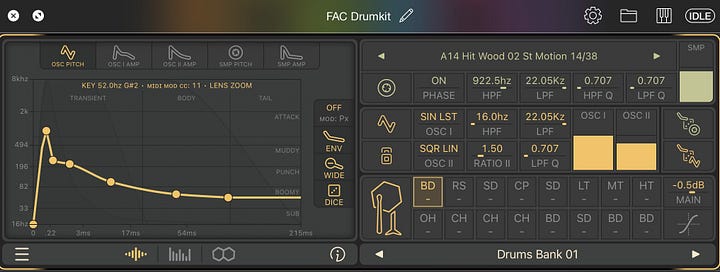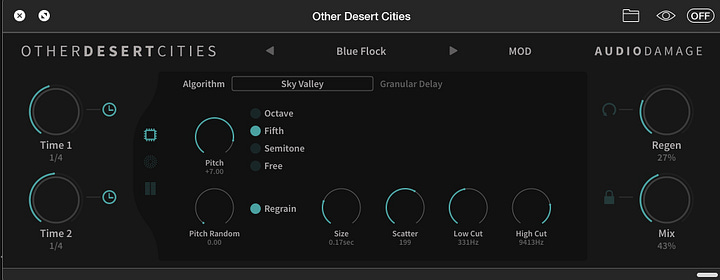Establishing a sound library and Loopy Pro templates
I’ve been working on a library of sounds, generated and recorded. Think of it as a curation of musical sound and ideas. Let’s explore!






Loopy Pro currently only available on the iPad (sometime soon, the Mac which I’m excited about) is at it’s heart a live looping application but it is way more than that. I use it as a recording tool for combining and exploring sound design ideas. I can add the virtual instruments I want to use, connect these to my external MIDI controllers and also audio inputs, so yes, can record guitars and vocals too. I’m not singing, don’t panic, I am looking forward to rediscovering the guitar though. That’s a post for another time, I’ve got some bits and bobs on order to resurrect my old electric!
Suffice to say, as you can see from the gallery of photos above, I’ve been building a template for the app, that I can use to get started quickly in order to explore the ideas that I have. It’s really frictionless, you can setup different ways of recording, with count-in options, audio threshold recording is ideal for me. Trigger a clip to record into and it’ll wait until the audio signal hits it and then kicks in. I will often do it that way, with either the metronome or a basic kick drum to help me stay in time.
Let’s have a listen to some of the sounds I’ve been recording into Loopy. I’ve been keeping myself amused, as you can tell, we have some drums, synths, guitar (not a real one though).
Then I’ll tell you about IPFS and how I’m creating a decentralised library of sounds online using it.
Drums
This drum loop was based on a nice simple pattern using Octachron as the step sequencer routed to FAC Drumkit. I note that this App scores a perfect 5 on the App Store, which is quite rare but it is fantastic, sounds great through big monitor speakers or headphones. I should do a Kit list at some point in time.


Octachron is a sequencer with drums in mind, it comes with mappings for popular drum apps, whether they are samplers or synths. It has one for FAC. This sequencer enables you to program a lot of probability into your sequences, to create some variety.
I’ve a choice here, as I can record the drums to a loop, which would then repeat the same performance over and over, which you may want or you can just let it play on it’s own as an instrument. That is what I love about Loopy, as you don’t have to record to clips if you don’t want to. It’s possible to load MIDI controllers into the app, with MIDI note data, let’s say basslines, chord progressions and let them run. You could also play those with audio loops and then record that with a live instrument on top. It’s insanely flexible.
I’ll write more about drum loops next time where I’ll build up an epic sequence of some sort. I love sequencing music, the process of building up a track be it 1 minute or 10, is always exciting.
Next up is a synth composition that I played live and recorded directly into a loop.
Synth pads
This time I made use of Copperhead a synth from developer 4 Pockets. I routed the audio through two effects to create an interesting tail as the notes are released on the keyboard, Eos 2 and Other Desert Cities (two apps from Audiodamage). More and more effects (and instrument) app developers are releasing products for multiple platforms which is great, I only own the iOS versions right now but shall probably get the VSTs at a later stage.


So these are reverb and delay effects with a lot of creative flexibility about them and deserve posts of their own to explore their capabilities and even then I doubt I’ll do them justice.
Here is a little list of the apps/plugins I’ve used in this post if you want to take a look at them yourselves.
IPFS
Let’s talk IPFS and an instance of it on NFT Storage, panic not, I am not going to actually use it for NFTs, it’s more of a large scale storage/hosting tool built on decentralised technology. In fact I could create my own IPFS instance, all I need would be some form of small computer to be online most of the time that people can download my files from. I believe this could potentially be a Raspberry Pi, maybe I’ll look into doing that as a project, however for now NFT Storage works and as a test, I’ve pasted in an HTTPS link below, just to see if it works with Substack before I go wild with it.
The same two loops in this post are available there for download, if you wanted to use them in your own productions. I’ll also make project files available there too.
https://bafybeiaygkqskcw7jqudby2zq2l7h3kcpefiok3hpalhmzti4444jdj3ya.ipfs.nftstorage.link/
Wrapping up
I said at the top that I want to curate sounds and that is the thing, the reason I write on Substack and Hive (I’ll write a dedicated post on the blockchain another time, it’s a big fascinating thing). You may have come across my two other Substacks
and which concentrate on photography and history? If not, please check them out.Curating sounds is as much about creating them as it is recording them, studying melodies, progressions and the many different instruments of the world. The scope is huge. So maybe creating a library of sound is a mad endeavour but I’ll just start it anyway.
I am going to leave it at that folks, as there is more to share from this Loopy Pro template, the idea being that I can duplicate it as many times as I need to work on new ideas, my scrapbooking process. It’s not yet finished. I’ll be back soon with some more sounds :-)



